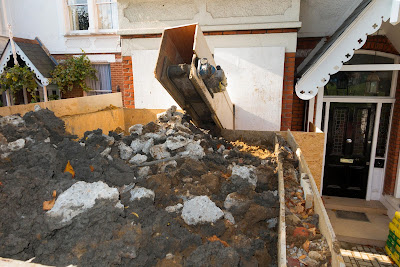For those wanting to extend a property in an
area of prime real-estate, where land is at a premium and extensions have already gone back, front and up, they have only one course left ... down.
Basement extensions are popular to add
further dimensions to valuable urban property, adding a study, reading room,
music room, perhaps a playroom or bedroom.
There are effectively three types of
basement: converting an existing basement into a useable, ventilated, well lit
and drained room(s), retrofitting a basement, excavating one below an existing
property; and adding one to the plans of a new build.
We’re looking particularly at the middle option here.
We’re looking particularly at the middle option here.
Before embarking on such a retrofit basement
project, please, please seek professional advice. Basement excavations do need
Planning Permission, mainly relating to the installation of a means of escape
or light wells as these affect the exterior appearance of the property.
As well as the obvious considerations:
access, party walls, existing infrastructure etc, two major considerations are
waterproofing and drainage.
In assessing
the viability of the project, consideration must be made for the following:
- Accessibility and affects on neighbouring properties.
- Geology, topography and the water table.
- The proposed use of the basement.
- Access from existing the property.
- Ventilation and light.
- Existing drainage.
Tanking, layers waterproof material directly to basement walls, ceiling and floor, encapsulating the space in a waterproof ceil. A cementitious waterproof render system is applied in several layers, linked to a waterproof screed on the floor.
Alternatively membranes are used to create an inner waterproof structure with a cavity (created by the membranes studded profile) behind it that is fully drained. The constant draining reduces any pressure build up on the exterior structure.
The pitfalls:
1. Failure to check the location of
existing drainage and services - Quite often existing sewers run across the
rear of properties, particularly terrace housing. Typically these sewers
are around 1.5m deep, just about head height in the proposed basement.
2. Following on from number 1, owners
naturally want to maximise basement space and extend right up to the plot
boundary. This offers a bigger new 'family room' but leaves no space to
divert the sewer. Manholes and drainage would now have to be located
outside the plot boundary, perhaps even on neighbouring land.
3. Following on from 2 regarding sewers.
The sewer may already be adopted by the water authority. Therefore any
works on or close to it would require a formal legal agreement of acceptance to
be put in place. Without it, building control may not sign it off.
4. Make sure the basement is fully
waterproofed with a membrane and sump pump system to drain anything low level
including light wells.
5. More of a tip to avoid a pit in which to
fall, bathrooms and WC's in a new basement require pumping. Installing pumping
systems further reduces usable space, so avoid using the basement for this
purpose. Keep them above ground level and with some careful planning they can
discharge via gravity.
A bonus pitfall: There is sometimes a risk of sewers
surcharging. A non-return valve is sometime a good idea to prevent flooding.
 |
| Click the image and enjoy the link. |
To avoid these pitfalls and many more, take professional advice,
contact Ben Norman and the team at
JMS Engineers on 01473 487047
We add
value to every project we have been,
are, and will be equally proud to support.
are, and will be equally proud to support.






No comments:
Post a Comment